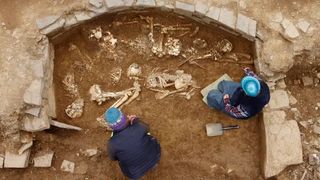5,000-year-old tomb holding hugging skeletons in Scotland is Neolithic 'feat of engineering'
Archaeologists in Scotland have discovered a hidden Neolithic tomb containing 14 skeletons.

Archaeologists in Scotland have unearthed a grave containing more than a dozen skeletons buried inside a 5,000-year-old stone-walled tomb.
The burial chamber's exact location had long been a mystery, even though the first written documentation of the grave occurred in the 19th century. A 1896 newspaper article dubbed the hidden tomb a "chamber cairn" when a farmer's son discovered it while exploring his family's homestead in the Orkney Islands, an archipelago off Scotland's northeastern coast, according to The Guardian.
In 2020, Hugo Anderson-Whymark, a senior curator of early prehistory at National Museums Scotland, was doing archival research when he came across the newspaper clipping published more than a century earlier.
"It was a bit of a detective story," Anderson-Whymark told Live Science. "By chance, there was other paperwork in the archive, including a tiny sketch outlining the [farm's] location."
Further sleuthing this summer led researchers to the site, which had become overgrown in the grassy, rolling landscape. Digging revealed a 49-foot-diameter (15 meters) tomb structurally reinforced by stone walls. The researchers deemed the tomb, which was built around 3000 B.C., "a Neolithic feat of engineering," according to The Guardian.
Related: Mysterious 'painted people' of Scotland are long gone, but their DNA lives on
This architectural achievement was due to the corbelled construction, in which workers had painstakingly built the stone walls so that they grew narrower as they reached the top of the structure.
Sign up for the Live Science daily newsletter now
Get the world’s most fascinating discoveries delivered straight to your inbox.
"As soon as we took the turf off the top it was apparent that what we had was quite a big monument," Anderson-Whymark told Live Science. "In 1896, [the farmer and his son] had taken away some of the archaeological deposits, including a stone mace head and ball, but they weren't interested in the eight human remains they had found and reburied everything."
In the bottom of the tomb, archaeologists unearthed six rooms containing 14 skeletons, including two that look like they’re hugging.
"They could've been buried at the same time in crouched positions like they were embracing," Anderson-Whymark said. "It looked like they were deliberately put in close relation to each other. We also found another skeleton whose arm was outstretched toward a different skeleton."
While additional research and DNA analysis are necessary to identify the individuals and determine whether they’re related, Anderson-Whymark described the site as a "very connected community." He noted that the structure is an anomaly; all other Neolithic tombs on Orkney are aboveground.
It appears that the tomb had stone markers above it, but the upper stones of the structure were quarried sometime during the 18th and 19th centuries to construct a nearby building that has since been demolished, according to The Guardian.
"The tomb would've been impressive to see when it was fully standing," Anderson-Whymark said. "It came within inches of being destroyed in the 19th century."

Jennifer Nalewicki is a Salt Lake City-based journalist whose work has been featured in The New York Times, Smithsonian Magazine, Scientific American, Popular Mechanics and more. She covers several science topics from planet Earth to paleontology and archaeology to health and culture. Prior to freelancing, Jennifer held an Editor role at Time Inc. Jennifer has a bachelor's degree in Journalism from The University of Texas at Austin.